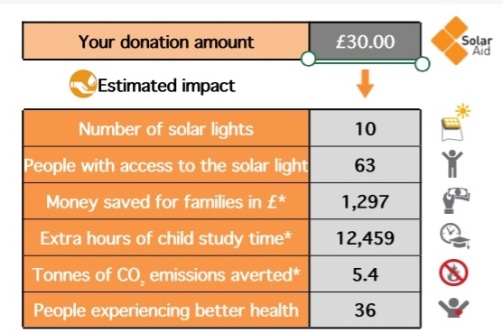 If you travel on the London tube you will see charity ads inside the carriages. Often they say £3 could do this or that. It’s part of the fundraisers obsession with hooking donations to activities or items (it’s the way we were taught to). Of course those of us in the know realise that £3 won’t actually be used to buy a mosquito net, or whatever, as some where will be the word ‘could’ or some variation (such as your £3 is ‘enough’ to buy this item – which again doesn’t mean your £3 will buy this item!). Somehow I think it waters down our ability to win people over – as its a twist of the truth. Yes £3 is the cost of a mosquito net but the £3 you give is not going to be used to buy one. Most likely it will a contribution as part of the organisations overall programme. Actually it belittles the true cost of making change happen: the cost to get that mosquito net into someone’s hands and ensure it has the impact you are seeking. That’s not to say £3 can’t make a difference – I believe it can as the example I am about to use will show.
If you travel on the London tube you will see charity ads inside the carriages. Often they say £3 could do this or that. It’s part of the fundraisers obsession with hooking donations to activities or items (it’s the way we were taught to). Of course those of us in the know realise that £3 won’t actually be used to buy a mosquito net, or whatever, as some where will be the word ‘could’ or some variation (such as your £3 is ‘enough’ to buy this item – which again doesn’t mean your £3 will buy this item!). Somehow I think it waters down our ability to win people over – as its a twist of the truth. Yes £3 is the cost of a mosquito net but the £3 you give is not going to be used to buy one. Most likely it will a contribution as part of the organisations overall programme. Actually it belittles the true cost of making change happen: the cost to get that mosquito net into someone’s hands and ensure it has the impact you are seeking. That’s not to say £3 can’t make a difference – I believe it can as the example I am about to use will show.
Using impact as the basis for your fundraising proposition
There is another way. Instead of using activities and their cost, focus on impact. Impact is the ultimate consequence of all your activities. It does mean you need to invest resources in determining it – but it’s worth it. Actually I think it’s more transparent than using activities as the basis for a fundraising proposition. An activity is just one part of all your work – it’s why you have to say your £30 ‘could’ fund this. Usually you have hundreds if not thousands of activities. But outputs are the sum total of your activities and impact is the consequence of your outputs. You may just have one or an handful of outputs and several impacts.
Let me give you an example. At SolarAid we have focused our programme on the distribution of solar lights and selling them at a fair market price in Africa. We have a dedicated research team who access the impact of our work. The purpose of this is to help us access if we are doing the right work, but it has added value when it comes to fundraising. For every £3/$5 donated we manage to sell a solar light at a fair market price in Africa. That’s simple inputs and outputs. You give £30 we are able to sell 10 more solar lights. This is the net cost of our operation, from fundraising through to implementation on the ground (what we need in addition to the income we get from selling lights in remote areas at a fair market price). £30 in 10 lights out. A few years ago we needed £6/$10 for every solar light we sold – it’s fallen as we have scaled up.
As a result of the field research the impact team have done we can now state the impact of a solar light. One solar light benefits 6 people, leads to 1 hours extra study, savings of $70 a year and averts over 200kg of CO2 a year. Put over three years, a prudent estimate for the lifetime of a solar light, that’s an extraordinary 1,200 hours study, $210 so saving and over 1/2 tonne of CO2
So donations funds activities that leads to outputs that delivers impact. If you can determine those outputs and the impact as a result of those outputs you can equate donations to impact. So we can now state the impact of your gift. So $50 would lead to an output of 10 solar lights which will avert 5 tonnes of CO2 over three years, or provide savings of over $2,000 or over 12 thousand hours of study. Take your pick!
 This led to the creation of our impact calculator. Potential donors type in the value of their gift and the calculator gives them the impact. Give it a go – click on the image or this link (don’t worry you don’t have to donate). We calculated the impact based on a prudent 3 year lifetime of a solar light. It even got highlighted in the Guardian recently. To learn more about the story behind it check out this guest blog here on Markets for Good.
This led to the creation of our impact calculator. Potential donors type in the value of their gift and the calculator gives them the impact. Give it a go – click on the image or this link (don’t worry you don’t have to donate). We calculated the impact based on a prudent 3 year lifetime of a solar light. It even got highlighted in the Guardian recently. To learn more about the story behind it check out this guest blog here on Markets for Good.
A new proposition – based on impact not activity
It gives a new basis for our fundraising propositions too. This is one we used during a UK Aid match appeal when all donations were doubled by the UK Government – so an individual’s donation of £3 became £6 and so their impact was doubled too.

We can use it in thank you’s too. We write to donors telling them the impact of their support over the last year in study hours, money saved and CO2 averted. Sometimes they share the graphics we produce. Here is an example for a donation of £30.
Use impact to improve your service AND inspire your donors
To use an impact proposition your organisation needs a focus – a clear set of outputs that you can access the impact of to verify you are on course to achieve your goal. At SolarAid this focus comes from our mission goal : to eradicate the kerosene lamp from Africa by the end of the decade. These outputs could be people trained, or wells built, or, patients treated. And then you need to equate donors inputs, i.e. donations, to those outputs and then those outputs to their impact. Research by New Philanthropy Capital, who provide guidance on the benefits to measuring impact, suggests donors like impact and it might even help boost gift levels (see fundraisers reviews on their report, Money for Good).
I suspect it’s not a viable approach for bigger outfits due to the diversity of their work, although perhaps this could be applied to different programmes. For those with a single minded focus, smaller players, it’s totally appropriate.
And it’s refreshingly transparent and different to ‘could’ ….





Pingback: The moment of giving – are you running on empty? | ifundraiser
Pingback: Confessions of a fundraiser | ifundraiser
Pingback: Stuff to inspire your next communications project.